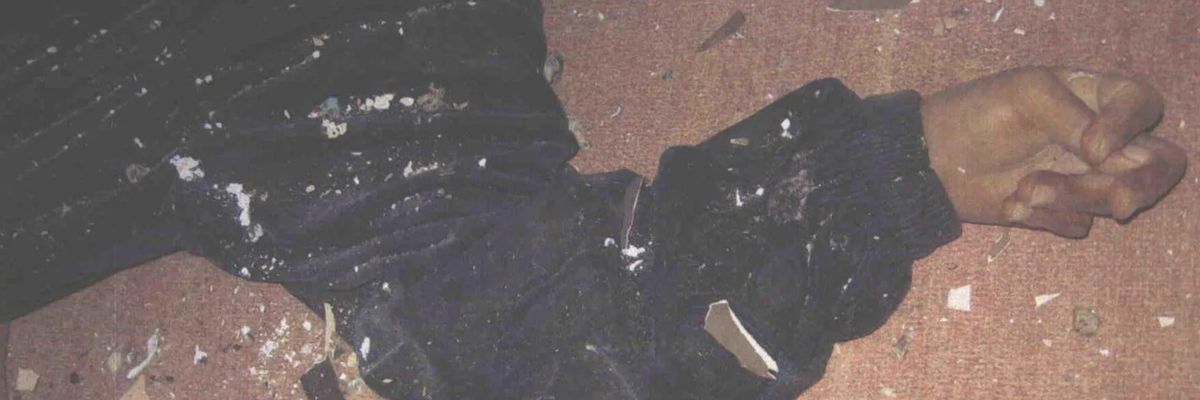After years of working with Iraqis whose relatives were killed by U.S. Marines in the 2005 Haditha massacre, American journalists finally obtained and released photos showing the grisly aftermath of the bloody rampage—whose perpetrators never spent a day behind bars.
On Tuesday, The New Yorker published 10 of the massacre photos—part of a collaboration with the "In the Dark" podcast that joined the magazine last year.
The podcast's reporting team had filed its public records request four years ago, then sued the U.S. Navy, Marine Corps, and Central Command over their failure to hand over the images. "In the Dark" host Madeleine Baran also traveled with a colleague to Iraq's remote Anbar Province to meet relatives of some of the 24 Iraqi civilians—who ranged in age from 1 to 76—slaughtered by U.S. troops.
"The impact of an alleged war crime is often directly related to the horror of the images that end up in the hands of the public."
Baran explained that she sought the relatives' help partly because "we anticipated that the government would claim that the release of the photos would harm the surviving family members of the dead," as "military prosecutors had already made this argument after the trial of the final accused Marine."
Khalid Salman Raseef, an attorney who lost 15 members of his family in the massacre, told Baran that "I believe this is our duty to tell the truth."
The graphic photos show dead Iraqi men, women, and children, many of them shot in the head at close range. One 5-year-old girl, Zainab Younis Salim, is shown with the number 11 written on her back in red marker by a U.S. Marine who wanted to differentiate the victims in photos.
On November 19, 2005, a convoy of Humvees carrying Marines of Kilo Company, 3rd Battalion, First Marine Division was traveling through Haditha when a roadside bomb believed to have been placed by Iraqis resisting the U.S. invasion killed Miguel Terrazas, a popular lance corporal, and wounded two other Marines.
In retaliation, Marines forced a nearby taxicab to stop and ordered the driver and his four student passengers out of the vehicle. Sgt. Frank Wuterich then executed the five men in cold blood. Another Marine then desecrated their bodies, including by urinating on them.
Wuterich then ordered his men to "shoot first and ask questions later," and they went house to house killing everyone they saw. They killed seven people in the Walid family home, including a toddler and an elderly couple.
"I watched them shoot my grandfather, first in the chest and then in the head. Then they killed my granny," Iman Walid, a survivor who was 8 years old when her family was slain,
toldTime in 2006.
Next, the Marines killed eight people in the Salim family home, six of them children. Finally, the troops executed four brothers in a closet in the Ahmad family home.
The Marines subsequently conspired to cover up what a military probe would deem a case of "collateral damage." The military initially claimed that 15 Iraqi civilians were killed by the same explosion that took Terrazas' life. However, a local doctor who examined the victims' bodies
said they "were shot in the chest and head from close range."
Eight Marines were eventually charged in connection with the massacre. Six defendants were found not guilty and one had their case dismissed. Initially charged with murder, Wuterich pleaded guilty and was convicted of dereliction of duty. He was punished with a reduction in rank and was later
honorably discharged from service.
Marine Corps Gen. James Mattis—who
earned his "Mad Dog" moniker during one of the atrocity-laden battles for the Iraqi city of Fallujah in 2004—intervened on behalf of the Haditha defendants and personally dismissed charges against one of them.
Later, while serving as former President Donald Trump's defense secretary, Mattis oversaw an escalation in what he called the U.S. war of "annihilation" against Islamic State in Iraq and Syria. The general warned that "civilian casualties are a fact of life in this sort of situation," and thousands of men, women, and children were subsequently slaughtered as cities including Mosul and Raqqa were leveled.
The Haditha massacre was part of countless U.S. war crimes and atrocities committed during the ongoing so-called War on Terror, which has
claimed hundreds of thousands of civilian lives in at least half a dozen countries since 2001. One of the reasons why the Haditha massacre is relatively unknown compared with the torture and killings at the U.S. military prison in Abu Ghraib, Iraq is that photos of the former crime have been kept hidden for decades.
"The impact of an alleged war crime is often directly related to the horror of the images that end up in the hands of the public," Baran wrote in the
New Yorker article. She noted that Gen. Michael Hagee, who commanded the Marines at the time of the Haditha massacre, later boasted how "proud" he was about keeping photos of the killings secret.
"This," journalist Murtaza Hussain
reminded the world on Tuesday, "is what the U.S. military was doing in Iraq."



